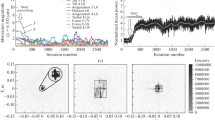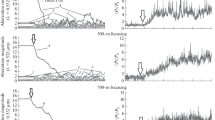Abstract—
Results of the numerical study of a possibility of compensating for aero-optical aberration distortions of the beam wavefront using the aperture sensing technique based on atmospheric backscatter signals are described. It is shown that the technique makes it possible to partially compensate for aero-optical aberrations. The cross section beam size becomes several times smaller than that of a beam without the wavefront adaptive control, and the intensity distribution becomes more symmetric about the optical axis.





Similar content being viewed by others
REFERENCES
V. A. Banakh, A. A. Sukharev, and A. V. Falits, “Diffraction of the optical beam on a shock wave in the vicinity of a supersonic aircraft,” Opt. Atmos. Okeana 26 (11), 932–941 (2013).
V. A. Banakh, A. A. Sukharev, and A. V. Falits, “Optical beam distortions induced by a shock wave,” Appl. Opt. 54 (2015).
V. A. Banakh, A. A. Sukharev, and A. V. Falits, “Manifestation of aero-optical effects in a turbulent atmosphere in supersonic motion of a conical body,” Atmos. Ocean. Opt. 28 (1), 24–33 (2015).
V. A. Banakh and A. A. Sukharev, “Laser beam distortions caused by a shock wave near the turret of a supersonic aircraft,” Atmos. Ocean. Opt. 29 (3), 225–233 (2016).
V. A. Banakh and A. A. Sukharev, “Contribution of atmospheric turbulence in distortions of laser beams caused by a shock wave arising at the supersonic flowing the turret,” Opt. Atmos. Okeana 29 (4), 257–262 (2016).
V. A. Banakh and A. A. Sukharev, “Aircraft subsonic speed impact on distortions of a laser beam propagating from the turret surface through a turbulent atmosphere,” Opt. Atmos. Okeana 30 (7), 575–580 (2017).
A. A. Sukharev, “Aeroptical effects caused by supersonic airflow around an ogival body,” Atmos. Ocean. Opt. 32 (2), 207–212 (2019).
V. A. Banakh, V. V. Zhmylevskii, A. B. Ignat’ev, V. V. Morozov, and I. N. Smalikho, “Collimation of the initial wavefront of a partially coherent light beam by the backscattered signal,” Opt. Spectroscop. 108 (1), 107–116 (2010).
V. A. Banakh, V. V. Zhmylevskii, A. B. Ignat’ev, V. V. Morozov, I. A. Razenkov, A. P. Rostov, and R. Sh. Tsvyk, “Optical-beam wavefront control based on the atmospheric backscatter signal,” Quantum Electron. 45 (2), 153–160 (2015).
M. Born and E. Wolf, Principles of Optics (Pergamon Press, Oxford, New York, 1970).
A. Ishimaru, Wave Propagation and Scattering in Random Media (Academic Press, 1978).
D. C. Wilcox, Turbulence Modeling for CFD (DCW Industries, Inc., La Canada, California, 2006).
A. S. Gurvich, A. I. Kon, V. L. Mironov, and S. S. Khmelevtsov, Laser Radiation in a Turbulent Atmosphere (Nauka, Moscow, 1976) [in Russian].
V. A. Banakh, D. A. Marakasov, and A. A. Sukharev, “Reconstruction of the structural characteristic of the refractive index and average air density in a shock wave arising in a supersonic flow past obstacles from optical measurements,” Opt. Spectroscop. 111 (6), 967–972 (2011).
K. Wang and M. Wang, “Aero-optics of subsonic turbulent boundary layers,” J. Fluid Mech. 696, 122–151 (2012).
Q. Gao, S. H. Yi, Z. F. Jiang, L. He, and Y. X. Zhao, “Hierarchical structure of the optical path length of the supersonic turbulent boundary layer,” Opt. Express 20, 16494–16503 (2012).
Q. Gao, S. H. Yi, Z. F. Jiang, L. He, Xi Wang, “Structure of the refractive index distribution of the supersonic turbulent boundary layer,” Opt. Laser. Eng. 51 (9), 1113–1119 (2013).
M. A. Vorontsov and V. I. Shmalgauzen, Principles of Adaptive Optics (Nauka, Moscow, 1985) [in Russian].
Funding
The study of compensation for laser beam wavefront aberration distortions induced by aero-optical effects was supported by the Russian Science Foundation (project no. 18-79-10115); development of models of optical inhomogeneities arising near an aircraft on atmospheric flight paths were supported by the Ministry of Science and Higher Education of the Russian Federation (V.E. Zuev Institute of Atmospheric Optics, Siberian Branch, Russian Academy of Sciences).
Author information
Authors and Affiliations
Corresponding authors
Ethics declarations
The authors declare that they have no conflict of interest.
Rights and permissions
About this article
Cite this article
Sukharev, A.A., Banakh, V.A. Compensation for Laser Beam Wavefront Aberration Distortions Induced by Aero-Optical Effects along Aircraft–Satellite Paths Based on Backscatter Signals. Atmos Ocean Opt 34, 313–319 (2021). https://doi.org/10.1134/S1024856021040126
Received:
Revised:
Accepted:
Published:
Issue Date:
DOI: https://doi.org/10.1134/S1024856021040126




